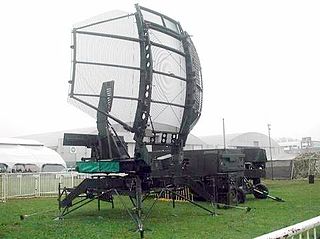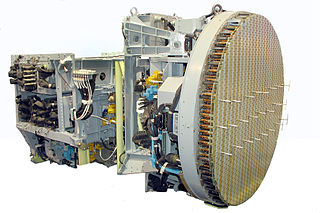
An active electronically scanned array (AESA) is a type of phased array antenna, which is a computer-controlled antenna array in which the beam of radio waves can be electronically steered to point in different directions without moving the antenna. In the AESA, each antenna element is connected to a small solid-state transmit/receive module (TRM) under the control of a computer, which performs the functions of a transmitter and/or receiver for the antenna. This contrasts with a passive electronically scanned array (PESA), in which all the antenna elements are connected to a single transmitter and/or receiver through phase shifters under the control of the computer. AESA's main use is in radar, and these are known as active phased array radar (APAR).

A pulse-Doppler radar is a radar system that determines the range to a target using pulse-timing techniques, and uses the Doppler effect of the returned signal to determine the target object's velocity. It combines the features of pulse radars and continuous-wave radars, which were formerly separate due to the complexity of the electronics.

Continuous-wave radar is a type of radar system where a known stable frequency continuous wave radio energy is transmitted and then received from any reflecting objects. Individual objects can be detected using the Doppler effect, which causes the received signal to have a different frequency from the transmitted signal, allowing it to be detected by filtering out the transmitted frequency.

The Type 364 radar was developed by the Yangzhou Marine Electronic Instruments Research Institute (扬州船用电子仪器研究所) / No. 723 Research Institute. It is typically enclosed in a dome on new PLA-N's frigates and destroyers.
Type 354 Radars are one of the most widely deployed air and surface search naval radars in Chinese service. The Type 354 was predominantly found on major People's Liberation Army Navy (PLAN) surface combatants such as the Luda class destroyer and Jianghu class frigate in the 1980s and 1990s. By 2006 it was slowly being replaced in favour of the Type 360 radar, which in turn, itself being replaced by Type 364 radar for new vessels.

The AN/TPS-43 is a transportable air search 3D radar produced in the United States originally by Westinghouse Defense and Electronic Division, which was later purchased by Northrop-Grumman. It is used primarily for early warning and tactical control, often for control over an associated surface-to-air missile battery or airfield. It is designed to be transported in two M35 cargo trucks and easily air-transportable on two pallets.

The Type 360 is an air/surface search radar manufactured by Yangzhou Marine Electronic Instruments Research Institute (扬州船用电子仪器研究所)/ No. 723 Institute and is reportedly based on Selenia RAN-10S / SPS – 774. It is deployed on a number of new PLAN vessels, such as the Ma'anshan class frigate.

Type 517 radar is believed to be an A-band/VHF air search radar widely deployed on PLAN surface vessels with 4 antennas in two crossed-brace supported pairs, one above the other, mounted in pairs on each side of a single tubular support carried on the turning gear.
The Type 347G "Rice Bowl" I-band fire-control radar is found on Chinese Navy ships, in conjunction with the Type 76A dual-37mm automatic AAA gun. Typically, the system includes 2 Type 347G fire-control radar with optical director, and 4 Type 76A guns. They're used on the Luda, Luhu, Luhai, Jiangwei class surface warships, as well as the Houjian, Houxin, and Haiging class patrol boats.
The JY-8 is a mobile 3D air surveillance, target acquisition and interception control radar system operating in the C-band. It can be employed as the main radar sensor for an automated tactical defence system, or can be used as an independent radar. The system uses advanced signal/data processor techniques and is fully solid state with the exception of the magnetrons and thyratrons of the transmitters. The general designer of JY-9 is the head of 38th Research Institute, academician of Chinese Academy of Sciences Mr. Wu Manqing, who is also the general designer of JY-9 and the general designer of the radar systems for KJ-2000 and KJ-200.

The AN/SPS-49 is a United States Navy two-dimensional, long range air search radar built by Raytheon that can provide contact bearing and range. It is a primary air-search radar for numerous ships in the U.S. fleet and in Spain, Poland, Taiwan aboard Oliver Hazard Perry-class frigates, Canada on its Halifax-class frigate and New Zealand on its Anzac-class frigates. It formerly served in a complementary role aboard Aegis cruisers with the AN/SPY-1 but the systems are currently being removed during routine upgrade with no replacement.

The AN/FPS-16 is a highly accurate ground-based monopulse single object tracking radar (SOTR), used extensively by the NASA crewed space program, the U.S. Air Force and the U.S. Army. The accuracy of Radar Set AN/FPS-16 is such that the position data obtained from point-source targets has azimuth and elevation angular errors of less than 0.1 milliradian and range errors of less than 5 yards (5 m) with a signal-to-noise ratio of 20 decibels or greater.

The AN/FPS-17 was a ground-based fixed-beam radar system that was installed at three locations worldwide, including Pirinçlik Air Base in south-eastern Turkey, Laredo, Texas and Shemya Island, Alaska.
The AN/FPQ-6 is a fixed, land-based C-band radar system used for long-range, small-target tracking. The AN/FPQ-6 Instrumentation Radar located at the NASA Kennedy Space Center was the principal C-Band tracking radar system for Apollo program.

The Bars (Leopard) is a family of Russian all-weather multimode airborne radars developed by the Tikhomirov Scientific Research Institute of Instrument Design for multi-role combat aircraft such as the Su-27, Su-30 and the MiG-29.
Radar in World War II greatly influenced many important aspects of the conflict. This revolutionary new technology of radio-based detection and tracking was used by both the Allies and Axis powers in World War II, which had evolved independently in a number of nations during the mid 1930s. At the outbreak of war in September 1939, both the United Kingdom and Germany had functioning radar systems. In the UK, it was called RDF, Range and Direction Finding, while in Germany the name Funkmeß (radio-measuring) was used, with apparatuses called Funkmessgerät . By the time of the Battle of Britain in mid-1940, the Royal Air Force (RAF) had fully integrated RDF as part of the national air defence.

ADEOS I was an Earth observation satellite launched by NASDA in 1996. The mission's Japanese name, Midori means "green". The mission ended in July 1997 after the satellite sustained structural damage to the solar panel. Its successor, ADEOS II, was launched in 2002. Like the first mission, it ended after less than a year, also following solar panel malfunctions.

AN/SPS-6 is a two-dimensional radar manufactured by Bendix and Westinghouse Electric. It was used by the US Navy as a first-generation air-search radar after World War II, and was widely exported to allies. In addition, the improved AN/SPS-12 is the derivative types developed in other countries.

AN/SPS-8 is a two-dimensional radar manufactured by General Electric. It was used by the US Navy as a height finding radar after World War II, and was equipped aboard naval ships during the Cold War. Variants include AN/SPS-8A, AN-SPS/8B, AN/SPS-8C and AN/SPS-8D After modernization, it was redesignated as AN/SPS-30.

Mark 63 Gun Fire Control System is a gun fire-control system made up of AN/SPG-34 radar tracker and the Mark 29 gun sight. They were usually equipped for the control of twin QF 4-inch naval gun Mk XVI and Mk.33 twin 3"/50 cal guns.















